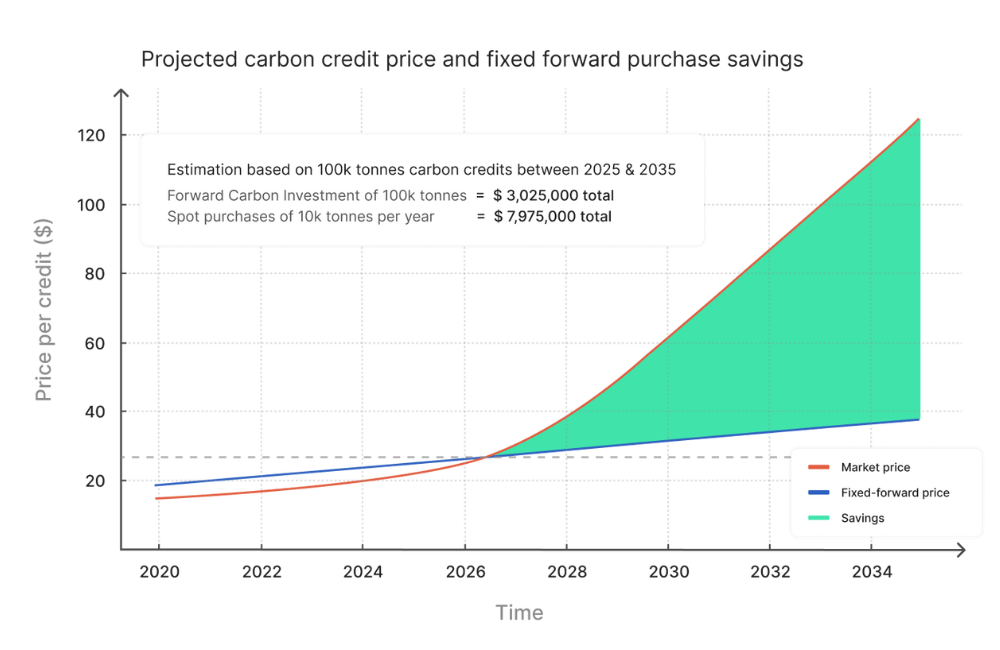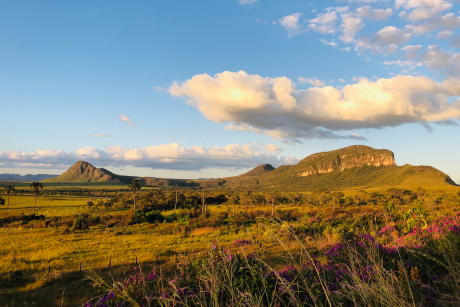28.05.2021
Carbon Accounting and Your Business Footprint
Our approach to business carbon accounting …
)
In today's global economy, the pressure on businesses to decarbonise is considerable. Stakeholders - from investors to customers - are demanding credible climate action and transparent reporting. For companies with ambitious ESG goals, navigating the complexities of the carbon market can be a significant challenge. While internal emission reductions are the cornerstone of any robust climate strategy, high-quality carbon credits play a crucial role in addressing unavoidable emissions and achieving true net zero ambitions.
However, the landscape of the voluntary carbon market is rapidly evolving. Simply reacting to market fluctuations and purchasing credits on the spot market is no longer a viable long-term strategy. This is where
emerges as a powerful, proactive approach.
This article will explore the concept of future carbon sourcing, explaining why it’s fast becoming a strategic pillar of corporate sustainability planning and how your business can leverage it to secure a natural legacy while achieving its climate goals.

is a proactive strategy that enables businesses to secure a long-term, reliable supply of high-quality carbon credits before scarcity, price hikes or policy shifts make it more difficult.
This forward-thinking approach allows businesses to move beyond the uncertainties of the spot market, locking in predictable pricing and ensuring a steady stream of high-quality credits from projects that have been thoroughly vetted for their environmental and social co-benefits. For companies wanting to take a more active role, future carbon sourcing offers the chance to co-develop new, impactful nature-based projects that align with their core values and sustainability objectives.
Carbon credit prices are rising, and the demand for high-quality credits is surging. An estimation we made, based on projected market prices, shows that securing 100,000 tonnes of carbon credits between 2025 and 2035 through a forward investment could cost approximately
$3 million
, whereas purchasing the same amount annually on the spot market could total nearly
$8 million
.

With more scrutiny being placed on credit types, methodologies and monitoring, leading companies are embracing beyond value chain mitigation (BVCM) and aligning their carbon strategies with the
.
The traditional model of purchasing readily available credits is no longer sufficient for long-term planning. The market is being reshaped by a wave of corporate climate commitments and new regulatory frameworks (like the
), which are fueling exponential demand. Simultaneously, the supply of genuinely impactful projects is severely restricted; as scrutiny intensifies, finding projects that meet the highest integrity standards is a significant challenge.
At Earthly, our rigorous
means only around 8% of projects we screen meet our strict criteria for quality. This widening gap between supply and demand is leading to price volatility and scarcity, exposing businesses that rely on reactive spot-market purchases to significant risks.

It is critical to remember that future carbon sourcing or carbon procurement should complement, not replace, a company's internal decarbonisation efforts. A robust strategy to reduce Scope 1, 2, and 3 emissions is the foundation of any credible net zero claim.
Future carbon sourcing then plays a vital role in addressing residual emissions and enabling companies to make a significant climate contribution "Beyond Value Chain Mitigation" (BVCM), a concept championed by initiatives like the Science Based Targets initiative (SBTi). By forecasting future unavoidable emissions and aligning credit procurement with long-term net zero milestones, businesses can create a holistic and credible climate strategy.
Future carbon sourcing allows businesses to support a diverse portfolio of
around the world. Here are a few examples of the types of projects you could facilitate:

Revive the Brazilian Cerrado
Once a vast mosaic of forests and grasslands, the Cerrado is now under severe threat. This ambitious regeneration project aims to restore over 12,000 hectares of degraded land through community-led natural regeneration, using native species to revive biodiversity, improve resilience and support rural livelihoods. Solar-powered water systems and sustainable farming practices help boost long-term independence for local farmers.

Restore Kenya’s forgotten mangroves
Decades of deforestation and pollution have devastated Kenya’s coastal mangrove forests, which are vital for local livelihoods and nature. This project focuses on community-led mangrove reforestation and assisted regeneration, restoring fish stocks, sequestering carbon and empowering local communities with the knowledge and tools for long-term stewardship.
The direction of the carbon market is clear: the future belongs to those who plan for it.
A proactive, strategic approach to carbon procurement is no longer just an option; it's an essential component of long-term climate resilience and corporate leadership. By moving from a reactive to a proactive stance, your business can secure its access to high-quality carbon credits, manage risks, and play a pivotal role in creating a more sustainable and nature-positive world.
At Earthly, we help businesses identify, assess and support high-integrity nature-based projects that deliver real climate, biodiversity and community impact. Our approach is grounded in scientific due diligence and long-term transparency. By partnering with Earthly, companies gain access to a pipeline of vetted opportunities, tailored project alignment, robust reporting and insurance-backed safeguards to de-risk long-term investments.
Want to dig deeper into future carbon sourcing?
Download our free comprehensive eBook, "
Future carbon sourcing: How businesses can secure a nature legacy,
" to explore case studies (including Microsoft and Kita), practical steps and more. And
to discuss with an advisor how your organisation can lead the way in the transition to a net zero future.
Related articles